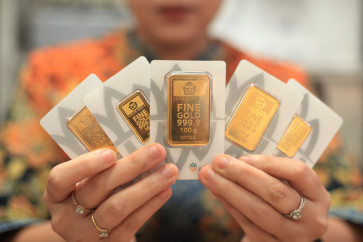Popular Reads
Top Results
Can't find what you're looking for?
View all search resultsPopular Reads
Top Results
Can't find what you're looking for?
View all search resultsAll about Wagyu
Ben Clifford (right) talks about wagyu beef during Wagyu Tasting while William Wongso looks on
Change text size
Gift Premium Articles
to Anyone
Ben Clifford (right) talks about wagyu beef during Wagyu Tasting while William Wongso looks on. (JP/Susanna Tjokro)
After reading an article on Wagyu, a friend said she felt a pang of envy.
"Imagine, the cows get massaged and drink beer or sake without having to work hard everyday and they enjoy luxurious life because their owners try to make them as happy as possible, simply because stress leads to tough meat," she said, "hence everything is done to minimize it -- they are indeed lucky, pampered cows."
However, as culinary expert William Wongso said, the reality is that massaging and drinking beer plus "listening" to classical music is more myth than fact these days.
"According to Shuzo Manno, a Japanese Wagyu fattening expert I met, those practices have not been done for 30 years," he said.
Wagyu means Japanese cattle and traditionally produced in Japan's Kobe region.
Wagyu beef is visually striking due to its marbling -- the term marbling refers to the fat between the muscle fibers. As more and more people tried this highly marbled, tender beef, the more they want to know what made it special -- and expensive.
William held "Wagyu Tasting" at his William Kafe Artistik on Dec. 17, 2008.
There were about 40 guests. Most of them were members of Jalansutra mailing list, including Bondan Winarno, a noted culinary expert.
"Actually this event is especially held for chefs and members of Jalansutra, because Bondan, the King of Jalansutra mailing list, is my best friend," William said.
The idea to throw the Wagyu tasting event was made after both Bondan and William engaged in lengthy discussions on Wagyu.
Charged Rp 200,000 per person, we had the opportunity to learn about Wagyu as well as tasting various grades of Wagyu, from F1 to F4.
I tasted each dish without feeling too full as the food was served in small portions. The beef came as mini beef burgers, satay, shabu shabu, black pepper rump, grilled rib eye and grilled strip loin.
William also invited Benn Clifford, an Australian beef grader with 35 years experience in grading beef. Clifford, among other things, enlightened us of the meaning of F1, F2, F3 and F4 stickers on Wagyu beef.
F1 is actually a result of a full-blooded Wagyu mating with a base breed of cow (in Australia, it is Angus) to produce a first cross or F1, which is 50 percent Wagyu and 50 percent Angus. The F1 female is then mated with a full-blooded Wagyu to produce a second cross or F2, thus the result is 75 percent Wagyu and 25 percent Angus.
Simply put it, Wagyu bull x Angus cow = F1, Wagyu bull x F1 female = F2, Wagyu bull x F2 female = F3, Wagyu bull x F3 female = F4 or the fourth cross, which is regarded a purebred or almost pure Wagyu.
Clifford also explained about the Beef Marbling Score (BMS). The score is based on three fats in beef: the surface fat, intramuscular fat (which is inside the muscle) and intermuscular fat (in-between the muscles)in other words, it is based on the density of marbling.
"However, when the meat is cooked, you cannot see the marbling as it disappears, goes through the muscles," Clifford said.
"We use a really simple system in Australia, the score starts from zero goes through to a marble score of 9, with 9 being the best and rarest. The cattle that produce a marble score 9, generally is very small in percentage. Out of 100 Wagyu carcasses, there would be 9 or 10 at the most, that produce a marbling score 9," he said.
In Japan, BMS ranges from 0 to 12 grade, 12 is actually too rich for many people, as higher scores correspond with more marbling or fat.
"I would rather to taste the meat than the fat. I cannot consume high marbling score Wagyu in large quantity -- 50 grams is the most," said William who prefers Wagyu of grade 2 and grade 3.
He said he was not a fan of grade 12 and thought people paid a high price for grade 12 Wagyu just to taste fat. "It is simply not worth the money," he said.
"The most expensive Wagyu in Japan is priced at 100,000 yen or US$1,000 per kg. I asked Shuzo Manno the reasons why it costs a lot of money because in Jakarta, we can buy a good size, good grading Kobe beef at US$120 per kg.
"Shuzo says that there are three reasons. First, that particular Wagyu has to be a gold medal winner. Second, it must be a heifer or a female cow that has not yet had a calf. And third, it has to be 30 months old and has been fattening for 20 months," William said.
"The grade of this kind of Wagyu is +12 for Japanese, meaning +15 for Australian. It is very pale, very white in color and contains a lot of fat.
"Kobe beef is from steers and Matsuzaka beef is from heifers. Matsuzaka beef has more marbling or fat than Kobe beef, hence it is more expensive than Kobe beef."
Kobe calves are castrated at four months. This practice is done to avoid a distinctive odor of the meat from sexually mature male cattle.
All Japanese cattle are named by where they are from, hence all Kobe beef is Wagyu, but not all Wagyu beef is Kobe. To bear the label of Kobe beef, the cattle must be raised in Hyogo prefecture -- the same thing also applies to Matsuzaka beef, only cattle raised in Mie prefecture can be labeled as Matsuzaka.
All in all, I personally think that "Wagyu Tasting" is worth every rupiah.
Borrowing a quote from William, the more you know about the food (its history and ingredients), the more you enjoy it.
William Kafe Artistik
Jl.Panglima Polim 65,
Kebayoran Baru
South Jakarta
Tel: 720-38-77










